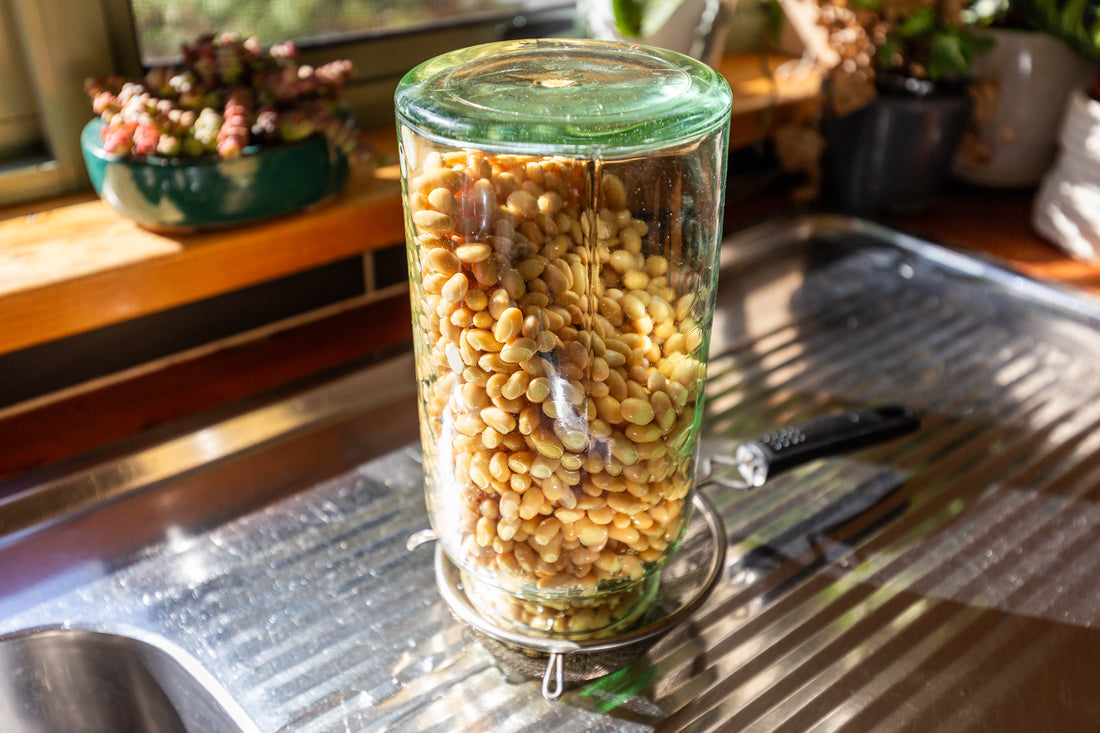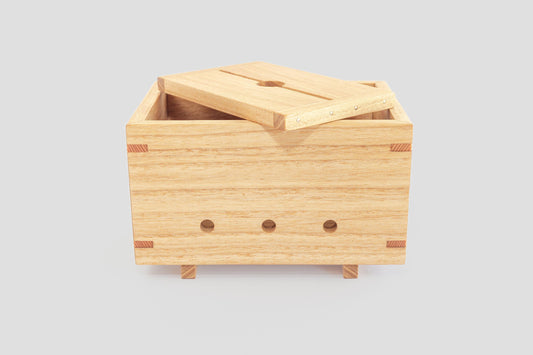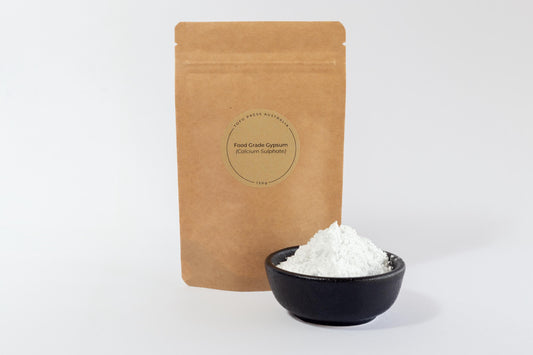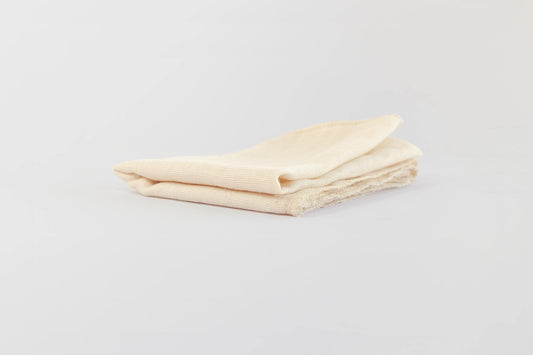
Tofu-Making Hacks: 5 Tips for Easier Making Tofu at Home
Making tofu at home can be a satisfying but messy and time-consuming process. In this article, we share five practical hacks to make the process cleaner, quicker and more consistent.
Use a Cold-Press Juicer
Anyone who’s made tofu at home before will be familiar with the messy stage: straining the soy milk. Usually, separating the soy milk from the okara (soy pulp) is done using muslin cloth and straining the liquid by hand after blending the soybeans with water into a smooth mixture. This is time-consuming, labour-intensive and unavoidably messy (I’ve had to clean okara off the ceiling before!). However, we have found a great solution to this problem: a cold-press juicer. Simply process the soaked soybeans in small batches, interspersed with water (use the same amount of water as usual) and then strain the soy milk through a sieve or colander into the pot that you plan to heat the soy milk in. Then proceed with your normal tofu recipe.
This method contains all the mess within the juicer and makes clean up much easier; it is also quicker than using the traditional blender-muslin method. Another plus to using this method is that the okara comes out quite dry, which makes it easier to use in recipes without adding other dry ingredients to soak up the excess moisture. Any cold press juicer should work but we’ve found this juicer from MOD Appliances to work well.
Perfect Coagulation with a Thermometer
Perfect coagulation of the soy milk into curds is dependent on a variety of factors, including protein and fat content of the soy beans, soy bean soaking time, type and amount of coagulant and richness of the soy milk. Perhaps the most important factor, however, is the temperature of the soy milk when the coagulant is added. If the soy milk is too hot, then the tofu can become very grainy. If it is too cold, then coagulation will be extremely slow or not happen at all. To ensure the best results, we recommend using a cooking thermometer to make sure the soy milk has dropped to the correct temperature before adding the coagulant. The ideal temperatures are as follows:
Gypsum (Calcium Sulphate): 80° - 82°C
Nigari (Magnesium Chloride): 74° - 76°C
If the ambient temperature of the room is quite cold (below 18°C), you may have to maintain the heat of the soy milk on a very low flame/setting until it finishes coagulating, particularly when using gypsum, as it is slower to curdle than nigari. Keep an eye on the temperature with your thermometer during this stage to make sure the soy milk doesn’t climb above the recommended temperature range.
Coagulants are usually mixed in a small amount of hot water before being added to the soy milk. This mixture should also be at a similar temperature to the soy milk to avoid dropping or raising the temperature of the soy milk.
Utilise Old Cartons
When using a tofu press to make tofu, it can be difficult to find appropriate weights that fit on the press (this is my we have designed our tofu presses with a flat lid; to allow for the placement of weights). We find that using old rectangular soy milk cartons, rinsed well and filled with water to be the perfect solution. These can be reused over and over again. Two cartons (2 kilograms) fit just right on our presses and provide the perfect amount of weight to press tofu to a medium firmness. We sometimes stack an extra carton on top on its side if we would like the tofu a little firmer. We usually leave our tofu to press for an hour but any time over 30 minutes is usually sufficient.
Make Use of By-Products
Making tofu produces two by-products: okara (soy pulp) and whey (liquid leftover from the coagulation process). Both these products can be used in a variety of different recipes. Okara is particularly versatile since it has a relatively neutral flavour and can be used in brownies, cakes, biscuits, burgers and savoury loaves. In Japan, the popular dish, unohana, features okara as the star ingredient. It adds moisture and a slight nutty flavour to recipes and is well worth experimenting with. Okara is rich in manganese, selenium, copper, calcium, iron and fibre.
Soy whey is the yellowish liquid left over after you remove the soy curds. It is typically thrown out; however, it has a range of uses. We like to drink the whey as is while it is still warm, it has a broth-like flavour and can be dressed up with a little bit of salt or vegetable stock powder, pepper and some shredded nori sheet. This can also be adapted to a noodle soup recipe, like udon, using soy whey as the base. Soy whey carries plenty of flavour and can be used as a replacement for stock or broth (with the addition of salt) in a variety of different dishes.
Another use for soy whey is as a coagulant for tofu! It can be fermented in jars for 3 days - a few weeks (depending on ambient temperature), during which time it forms lactic acid, which can then be used as a replacement for gypsum or nigari. Depending on the acidity of the fermented whey, you will need to use approximately 1.5 cups of whey where you would normally use 1.5 teaspoons of gypsum or nigari. This process is commonly used in commercial tofu production in asian countries.
Boost Protein Content by Sprouting
Sprouting has long been used as a way to boost the nutritional value and digestibility of legumes, nuts and seeds. It is no different with soybeans. Germinating soy beans before using them increases the protein content in tofu by 13% and decreases fat by 12%. Additionally, sprouted soy bean tofu contains 81% less trypsin inhibitor and 56% less phytic acid. This means a higher bioavailability of minerals (due to less phytic acid) and easier digestion of proteins (due to less trypsin inhibitor).
To make sprouted tofu, soak the beans overnight or for 8-12 hours as you normally would, then drain the beans and leave to sprout. Rinse and drain the beans 2-3 times a day until they form tails, then use them as normal in your tofu-making recipe. The beans should take 2-3 days to sprout following soaking; however, in cooler climates they may be slow to sprout and may start to ferment if left for too long!
We’ve found that we get a higher yield of tofu from sprouted soy beans, which is probably due to the increased protein content. Sprouted tofu has a softer texture than regular tofu, so it may not be suitable for dishes where structural integrity is important. The flavour is slightly sweeter than your average tofu and a little less ‘beany’.
With just a few tweaks to your tofu-making process, you can use these tips to save time, reduce mess and get more from your soybeans. We hope these simple hacks help to improve your homemade tofu and make the whole experience much more enjoyable!
Happy tofu-making 🌿
Sources:
Effect of sprouting of soybean on the chemical composition and quality of soymilk and tofu



